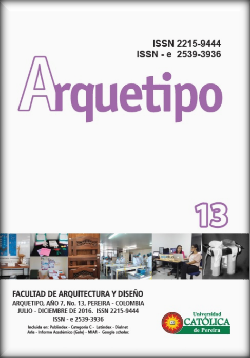Mobility of the horse-drawn transport system in urban environment. Study case: Pereira City – Colombia
Keywords:
Urban transport, Mobility, traction carts, equine maltreatmentAbstract
This article presents the mobility of horse-drawn transport system in the city of Pereira, in function of the variables of slope gradient, speed, load and frequency of service, in order to diagnose the work system environment and labor conditions of the drivers. The technical functioning is analyzed through a mobility methodology. The data are systematized in the geographic information software and calculation processor. The maximum slopes gradients transited were of 8 to 25 %. The 42 % of systems transported loads of 10 to 500 kg of weight, on average speed between 0,29 y 3,58 km/h. The maximum travels in one day were of 6 to 10 in the 44 % the focus group. The fact that this type of transport exists implies that more research is needed on its technical and mobility aspects.
References
Alelí (2014, 9 de noviembre) Galope a golpes. La Habana. Recuperado de http://www.14ymedio.com/blogs/origenes/animales-caballos_7_1631306854.html
De Aluja, A. S. (1998). The welfare of working equids in Mexico. International Donkey Protection Trust (IDPT), International League for the Protection of Horses (ILPH). México: Universidad Nacional Autonoma de México (UNAM).
Devonshire-Ellis, C. (2010, 3 de junio). Recuperado de http://www.2point6billion.com/news/2010/06/03/rural-life-still-influential-in-china-and-india’s-urbancities-5871.html
Beltrán, J.M. (1954). Ganado caballar. Barcelona, España: Salvat.
Cabezas, J., Valenzuela, S., Merino, V., Riquelme, J., García, M., Hertz, E. y Pérez, R. (1994). Rendimiento físico, requerimientos energéticos y adaptación fisiológica del caballo de tiro en faenas de aradura. Archivos de Medicina Veterinaria, XXVI (2), 12-28.
Colombia (1970, agosto 4). Decreto 1355. Código Nacional de Policía. Presidencia de la República.
Colombia (1989, diciembre 29). Ley 84. Estatuto Nacional de Protección de los Animales. Congreso de la República.
Colombia (1999). Constitución Política de Colombia. Bogotá: Legis Editores, 3ra Edición.
Colombia (2002, agosto 6). Ley 769. Código Nacional de Tránsito Terrestre. Congreso de la República.
Colombia (2012, enero 27). Decreto 178. Por el cual se establecen medidas relacionadas con la sustitución de vehículos de tracción animal. Presidencia de la República.
Colombia (2000, febrero 15). Ley 576/2000 Código Ética para el Ejercicio Profesional de la Medicina Veterinaria y Zootecnia. Congreso de la República.
Comisión Primera Constitucional Permanente (2014, septiembre 4). Proyecto de Ley 087/2014C. Informe de ponencia segundo debate. Gaceta 241/2015.
Fady, D. (2009, 12 de noviembre). Ramassage des déchets verts et insertion sociale à l’aide du cheval à Lucerne (Suisse). Recuperado de http://hippotese.free.fr/blog/index.php/tag/déchets%20verts
FAO (Food and Agriculture Organization) (2011). The Brooke. Electronic Consultation on The role, impact and welfare of working (traction and transport) animals. Recuperado de http://www.fao.org/fileadmin/user_upload/animalwelfare/FAOThe%20Brooke%20working%20animals%20e-consultation%20report.pdf
FAOSTAT (Food and Agriculture Organization Statistic) (2009). Working horses. Recuperado de http://faostat.fao.org/site/573/DesktopDefault.aspx?PageID=573#ancor
Funny photo imran khan. (s.f.). India. Recuperado de http://www.slideshare.net/AmazonWebServices/session-2se
García Ospina, L. M. (2017). Análisis Funcional del Transporte Equino Urbano.Manizales: Universidad Nacional de Colombia, sede Manizales.
Guianza Express LTDA (s.f.). Recuperado de http://www.guianzaexpresscartagena.com/nuestros_tours_3.htm
Guiinot, P. (2009). Un phénomène de Société durablement enraciné. Recuperado de: http://www.chevaux-haute-normandie.com/fr/actualites/information-filiere/bilan-eme-congres-des-chevaux-territoriaux,8405.html
Marín, J G. (2003). Estudio Socioeconómico. Monografía no publicada. Instituto de Tránsito y Transporte de Pereira.
McShane, C. y Tarr, J. (2003). The decline of the urban horse in American cities. Journal of Transport History, 24 (2), 177-199.
Mohita Nagpal (2011, 7 de agosto). Bumpy ride: Delhi tongas on their last legs recuperado de https://in.news.yahoo.com/bumpy-ride-delhi-tongas-lastlegs-065301631.html
Moller, R., Beltrán, D. y Jiménez, F. (2009). Transporte urbano sostenible y la calidad de vida para los municipios de Colombia. Programa editorial Universidad del Valle: Colección Libros de investigación.
Moreyra, A. (2008, 27 de mayo). Asociación protectora de animales y ecologista de Quilmes. Recuperado de http://www.apaeq.org.ar/proyectotraccionasangre.html
Pearson, R. A. (2005). Contributions to society: draft and transport. En: G. Pond y B. Wilson, Encyclopedia of Animal Science (pp. 248–249). Estados Unidos de Norte América: CRC Press.
Rahman S.A., Walker L. y Ricketts W. (2005). Global perspectives on animal welfare: Asia, the Far East, and Oceania. Rev. Sci. tech, 24 (2), 597-610.
Sevilla, C.C. (1995). The use of draft animals and the potencial of the draft cow system in the Philippines. En: E. Zerbini, B. Shapiro y J. C. Chirgwin (Eds.), Cows for Milk, Meat and Traction in Smallholder Farming Systems (pp. 93-108). Ethiopia: ILRI (International Livestock Research Institute).
Serrano, E. (2012, 2 de julio) Cuba a través de los ojos de una periodista estadounidense. Recuperado de http://www.anhelos-y-esperanzas.com/2012/07/cuba-traves-de-los-ojos-de-una.html
Starkey P., Hanekom D., Lake T., Meikle, G. y Jaiyesimi-Njobe, F. (1995). Animal traction in South Africa: the present situation. Editor Starkey Paul. En: Animal Traction in South Africa: empowering rural communities. South Africa, A DBSA-SANAT publication.
Starkey, P. y Starkey, M. (2000). Regional and world trends in donkey populations. En Starkey, P. y Fieldding, D. (eds.) Donkeys, people and development, Regional and world trends in donkey populations. Recuperado de http://www.atnesa.org/donkeys/donkeys-starkey-populations.pdf
Tadich, T., Escobar, A. y Pearson, RA (2008). Husbandry and welfare aspects of urban draught horses in the south of Chile. Aspectos de manejo y bienestar en equinos de tiro urbano en el sur de Chile. Archivos de Medicina Veterinaria, 40(3), 267-273.
Tracción Animal y Tenencia Responsable de animales (2006, 16 de mayo). Sociedad Uruguaya: Mirate. Uruguay. Recuperado de http://www.sociedaduruguaya.org/2006/05/traccion-animal-y-tenencia-responsable-de-animales.html
WSPA (World Society for the Protection of Animals) (2009a). History of WSPA involvement. Recuperado de http://www.elrefugioanimal.org/Noticias/headline1.
WSPA (World Society for the Protection of Animals) (2009b). Improving the lives of Colombia’s working horses. Recuperado de http:// www.wspa-international.org/wspaswork/workinghorses/improvinghorseslivescolombia.aspx
WSPA (World Society for the Protection of Animals) (2009-2011). History of WSPA involvement.
Youatt, W. (1831). The Horse, with a Treatise on Draught and a Copious. London: Baldwin and Cradock.

